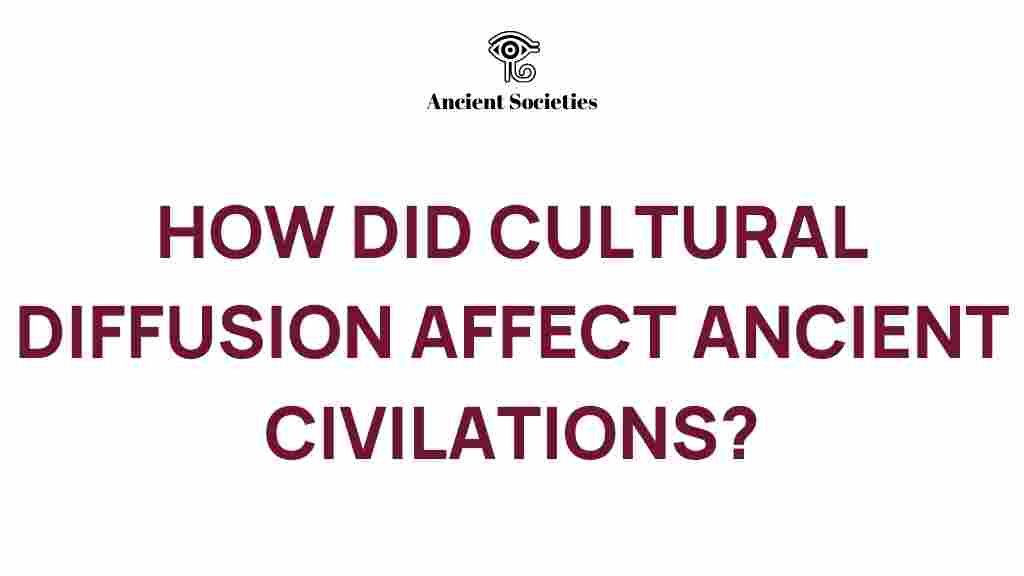Unraveling the Impact of Cultural Diffusion on Ancient Civilizations
The study of ancient civilizations reveals a tapestry of human experience woven together through the threads of cultural diffusion. This phenomenon, defined as the spread of cultural beliefs and social activities from one group to another, has played a pivotal role in shaping societies throughout history. In this article, we will explore how cultural diffusion has influenced ancient civilizations through trade, migration, innovation, and cultural exchange, ultimately contributing to social development and the roots of globalization.
Understanding Cultural Diffusion
Cultural diffusion can be understood as a process where cultural elements such as beliefs, practices, technologies, and languages are transmitted from one society to another. This exchange can occur in various ways, including:
- Trade: The exchange of goods often brings with it ideas and practices from different cultures.
- Migration: When people move, they carry their culture with them, influencing the new societies they enter.
- Innovation: New inventions or ideas often spread rapidly across cultures, altering local practices.
- Cultural Exchange: Diplomatic relations and intermarriage can facilitate the sharing of customs and traditions.
The Role of Trade in Cultural Diffusion
Trade has been a significant catalyst for cultural diffusion, especially in the context of ancient civilizations. The Silk Road, for example, connected the East with the West, allowing not only for the exchange of goods but also for ideas, religions, and technologies.
Key elements of trade contributing to cultural diffusion include:
- Marketplaces: Centers of trade were often melting pots of different cultures.
- Merchants: Traders acted as conduits for cultural exchange, sharing stories and practices.
- Goods: Products from one region often influenced local customs and lifestyles.
Migration and Its Impact on Cultural Diffusion
Migration has historically led to significant cultural diffusion. As people moved in search of better opportunities or due to conflicts, they brought their cultures with them. The spread of the Indo-European languages, for example, is attributed to migration patterns across Europe and Asia.
Examples of migration influencing ancient civilizations include:
- The Bantu Migration: This movement across Africa led to the spread of agriculture, ironworking, and languages.
- The Aegean Sea migrations: These movements during the Bronze Age facilitated cultural exchanges among the Greeks and other civilizations.
Innovation as a Vehicle for Cultural Diffusion
Innovation serves as a powerful force in the process of cultural diffusion. The development of new technologies often requires the sharing of ideas and methods across cultures. For instance, the invention of the wheel in Mesopotamia not only transformed transportation but also influenced trade practices across surrounding regions.
Innovations that spread through cultural diffusion include:
- Agricultural Techniques: The introduction of new farming methods improved food production in various regions.
- Writing Systems: The spread of cuneiform and hieroglyphics facilitated record-keeping and communication.
- Architectural Styles: Techniques from one civilization often influenced the construction methods of another.
Cultural Exchange and Its Significance
Cultural exchange, often facilitated through diplomacy, marriage, and war, has been crucial in the process of cultural diffusion. As civilizations interacted, they influenced each other’s customs, arts, and social structures. The Hellenistic period, following the conquests of Alexander the Great, exemplifies this phenomenon, where Greek culture blended with Eastern influences.
Key aspects of cultural exchange include:
- Religion: The spread of major religions like Buddhism, Christianity, and Islam was often facilitated through cultural exchanges.
- Art and Literature: The exchange of artistic styles and literary works enriched various cultures.
- Philosophy and Science: Philosophical ideas and scientific knowledge often crossed cultural boundaries, enhancing human understanding.
The Interconnection of Cultural Diffusion and Social Development
The impact of cultural diffusion on social development in ancient civilizations cannot be overstated. As cultures interacted and blended, new social structures emerged, leading to advancements in governance, law, and community organization.
Some effects of cultural diffusion on social development include:
- Legal Systems: The sharing of legal codes, such as the Code of Hammurabi, influenced governance in various regions.
- Social Hierarchies: Interactions between cultures often led to the establishment of new social classes and roles.
- Community Building: Cultural exchanges fostered a sense of community among diverse groups, enhancing social cohesion.
Cultural Diffusion and the Roots of Globalization
The processes of cultural diffusion in ancient civilizations laid the groundwork for modern globalization. As cultures interacted and shared ideas, they contributed to a more interconnected world. Today, the effects of this historical phenomenon can be seen in the global exchange of culture, technology, and ideas.
Key connections between cultural diffusion and globalization include:
- Global Trade Networks: The establishment of trade routes continues to facilitate the exchange of goods and ideas worldwide.
- Migration Trends: Modern migration patterns reflect historical movements, influencing cultural landscapes globally.
- Technological Advancements: Innovations continue to spread rapidly, similar to how they did in ancient times, shaping global culture.
Troubleshooting Cultural Misunderstandings
Despite the benefits of cultural diffusion, misunderstandings can arise. Here are some tips to navigate potential challenges:
- Education: Promote awareness of different cultures to foster understanding.
- Communication: Encourage open dialogue about cultural practices and beliefs.
- Respect: Emphasize the importance of respecting cultural differences and finding common ground.
Conclusion: The Lasting Legacy of Cultural Diffusion
The impact of cultural diffusion on ancient civilizations is profound and enduring. Through trade, migration, innovation, and cultural exchange, societies have shaped one another, leading to significant advancements in social development. Understanding this historical process helps illuminate the roots of present-day globalization and the interconnectedness of cultures. As we continue to navigate our global society, the lessons learned from cultural diffusion remain vital for fostering mutual respect and understanding among diverse communities.
For further reading on the history of cultural diffusion and its impact on civilizations, check this resource. You can also explore related topics on our site here.
This article is in the category History and created by AncientSocieties Team
